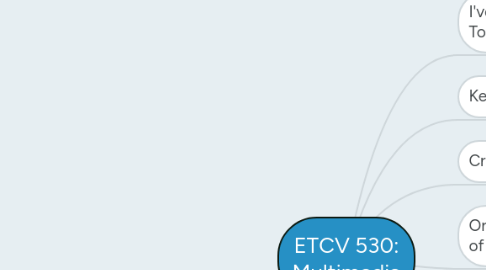
1. I've Been Thinking Topics
1.1. Value of "in person" undergraduate education?
1.2. Whether technology interferes with student learning
1.3. Simulated classrooms
1.4. How to make online training modules more interesting
1.5. Using film in class
1.6. Scratch - learning computer programming in class
1.7. LMS - different systems, pros/cons, comparison to in-person teaching
1.8. Using elements of PBL in the classroom
1.9. Using an LMS or other digital tool in a creative way
1.10. Is there such thing as "too much" tech?
2. Creativity
2.1. Sources on Creativity
2.1.1. TED: Ken Robinson 1
2.1.2. TED: Ken Robinson 2
2.1.3. TED: Tim Brown
2.2. Thinking Creatively Examples
2.2.1. I've Been Thinking Forum and student-led discussions
2.2.2. Group Assignment for PA 552
3. Keeping Current
3.1. Value in having up-to-date knowledge
3.1.1. particularly important for digital tools
3.2. Tool: RSS Readers/feeds
4. Organization of Ideas
4.1. Mindmapping
4.1.1. Mind mapping as a tool of organization
4.1.2. Source: How to Use MindMapping
4.1.3. Tool: MindMeister
5. Expressing Information
5.1. Importance of visuals to communication - facts, figures, data, graphs
5.2. Infographics
5.2.1. Information on creating infographics
5.2.1.1. Kathy Schrock's infographics guide
5.2.1.2. Infographic Designs: Overview, Examples and Best Practices
5.2.2. Tools to create infographics
5.2.2.1. 10 free tools
5.2.2.2. 20 Tools for infographics
5.2.2.3. Venngage
6. Protecting Digital Tattoo
6.1. Importance of protecting yourself online
6.1.1. Your information
6.1.2. Your privacy
6.1.3. From bullying
6.1.4. TED: Your online life, protecting your reputation and identity online
6.2. Sources
6.2.1. Best practice: protecting your reputation and identity online
6.2.2. EFF's Top 12 Ways to Protect your online privacy
6.2.3. Nine themes of digital citizenship
6.2.4. Text unto others
6.2.5. Core rules of netiquette
6.2.6. Text messaging etiquette
6.2.7. Office worker sacked for writing emails in block capitals
6.3. Example: Privacy policy for the ISS capstone course (completed assignment)
7. Digital Tool Box
7.1. Explosion of digital tools for education, or that can be purposed for education
7.2. Tools from students - digital toolbox assignment
7.2.1. Netflix
7.2.1.1. To supplement course materials with videos
7.2.1.2. Documentaries and related fiction shows
7.2.2. Zotero
7.2.2.1. To encourage proper use of citations
7.2.2.2. Use groups to develop research projects or bibiliographies
7.2.2.3. Download from Zotero.org
7.2.3. Countries of the world
7.2.3.1. To learn global geography
7.2.3.2. App on android devices
7.2.4. Panopto
7.2.4.1. To develop and share video presentations
7.2.4.2. Available to all UA students
7.2.5. Classroom response devices (clickers)
7.2.5.1. For attendance, polls, asking questions, for feedback, etc.
7.2.5.2. Visual confirmation of student engagement
7.2.6. Weebly and Wix
7.2.6.1. Website builders
7.3. Tools used in ETCV 530
7.3.1. Synchronous Classes
7.3.1.1. Adobe Connect
7.3.2. RSS Readers
7.3.2.1. Feedly
7.3.2.2. FeedReader
7.3.2.3. The Old Reader
7.3.2.4. FlipBoard
7.3.3. Mind Mapping
7.3.3.1. MindMeister
8. Project-Based Learning
8.1. Description
8.1.1. What is PBL - Buck Institute
8.1.2. "Project Based Learning is a teaching method in which students gain knowledge and skills by working for an extended period of time to investigate and respond to an engaging and complex question, problem, or challenge."
8.2. Resources
8.2.1. The main course, not dessert
8.2.2. 8 Essentials for project-based learning
8.2.3. Sample PBL projects
8.2.3.1. From BIE
8.2.3.2. From Edutopic
8.2.4. How to get high-quality student work in PBL
8.2.5. Webinar on developing driving questions
8.3. Tools to develop new PBL
8.3.1. BIE's project planner
8.3.2. Project design rubric

